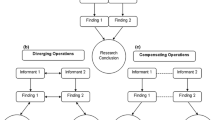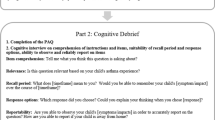Abstract
In clinical and research settings, it is increasingly acknowledged that adolescents may be better positioned than their caregivers to provide information in regard to their own health status, including information related to asthma. Very little is known, however, about the congruence between adolescent and caregiver responses to questions about asthma beyond reports of symptoms. We analyzed data for 215 urban, primarily African-American adolescent–caregiver pairs. Adolescents and caregiver reports concerning the adolescent’s asthma-related medical history were moderately correlated and not found to differ at the aggregate level. Correlations between adolescent and caregiver reports of the adolescent’s asthma symptoms and functional status were weak, although these differences deteriorated at the aggregate level. Adolescent–caregiver reports of symptoms and functioning were more likely to be in agreement if the adolescent was older, if school personnel were unaware of the child’s asthma, and if the adolescent’s asthma was classified as mild intermittent. For questions concerning the frequency of hospitalizations, emergency department visits, and physician visits, moderate correlations between adolescent and caregiver responses were noted, although with some differences at the aggregate level. Findings suggest that, when adolescents and their caregivers are asked about the adolescent’s asthma in clinical and research settings, the extent to which the two perspectives are likely to agree depends on the type of information sought. Clinicians and researchers may obtain more accurate information if questions about symptoms and functional status are directed toward adolescents.
Similar content being viewed by others

References
Menon G, Bickart B, Sudman S, Blair J. How well do you know your partner? Strategies for formulating proxy-reports and their efforts on the convergence to self-reports. J Mark Res. 1995; 32: 75–84.
Braun-Fahrlander C, Gassner M, Grize L, et al. Comparison of responses to an asthma symptom questionnaire (ISAAC core questions) completed by adolescents and their parents. SCARPOL team. Swiss Study on Childhood Allergy and Respiratory Symptoms with Respect to Air Pollution. Pediatr Pulmonol. 1998; 25: 159–166.
Renzoni E, Forastiere F, Biggeri A, et al. Differences in parental- and self-report of asthma, rhinitis and eczema among Italian adolescents SIDRIA collaborative group. Eur Respir J. 1999; 14(3): 597–604.
Lara M, Duan N, Sherbourne C, et al. Differences between child and parent reports of symptoms among Latino children with asthma. Pediatrics. 1998; 102: e68.
Clark NM, Brown R, Joseph CL, et al. Issues in identifying asthma and estimating prevalence in an urban school population. J Clin Epidemiol. 2002; 55: 870–881.
National Heart, Lung & Blood Institute. Expert panel report 3: guidelines for the diagnosis and management of asthma. Bethesda: National Institutes of Health; 2007.
Juniper EF, Wisniewski ME, Cox FM, et al. Relationship between quality of life and clinical status in asthma: a factor analysis. Eur Respir J. 2004; 23: 287–291.
Akinbami LJ, Moorman JE, Garbe PL, Sondik EJ. Status of childhood asthma in the United States, 1980–2007. Pediatrics. 2009; 123(Suppl 3): S131–S145.
Joseph CL, Peterson E, Havstad S, et al. A web-based, tailored asthma management program for urban African-American high school students. Am J Resp Crit Care. 2007; 175: 888–895.
Asher MI, Keil U, Anderson HR, et al. International Study of Asthma and Allergies in Childhood (ISAAC): rationale and methods. Eur Respir J. 1995; 8: 483–491.
National Asthma Education and Prevention Program. Guidelines for the diagnosis and management of asthma: expert panel report 2. Hyattsville: U.S. Department of Health and Human Services; 1997.
Marshall SK, Tilton-Weaver L, Bosdet L. Information management: considering adolescents regulation of parental knowledge. J Adolesc. 2005; 28: 633–647.
Chang P, Yeh C. Agreement between child self-report and parent proxy-report to evaluate quality of life in children with cancer. Psychooncology. 2005; 14: 125–134.
Drotar D. Measuring child health: scientific questions, challenges, and recommendations. Ambul Pediatr. 2004; 4: 353–357.
Guyatt GH, Juniper EF, Griffith LE, Feeny DH, Ferrie PJ. Children and adult perceptions of childhood asthma. Pediatrics. 1997; 99: 165–168.
Thorton A, Orbuch TL, Axinn WG. Parent–child relationships during the transition to adulthood. J Fam Issues. 1995; 16: 538–654.
Borgers N, de Leeuw E, Hox J. Children as respondents in survey research: cognitive development and response quality. Bull Methodol Sociol. 2000; 66: 60–75.
D’Souza-Vazirani D, Minkovitz CS, Strobino DM. Validity of maternal report of acute health care use for children younger than 3 years. Arch Pediatr Adolesc Med. 2005; 159: 167–172.
Sudman S, Bradburn NM, Schwarz N. Thinking about answers: the application of cognitive processes to survey methodology. San Francisco: Jossey-Bass; 1996.
Bower GH, Gilligan SG. Remembering information related to one’s self. J Res Pers. 1979; 13: 420–432.
Rogers TB, Kuiper NA, Kirker WS. Self-reference and the encoding of personal information. J Pers Soc Psychol. 1977; 35: 677–688.
Brewer W. Memory for randomly selected autobiographical events. In: Neisser U, Winograd E, eds. Remembering considered: ecological and traditional approaches to the study of memory. Cambridge: Cambridge University Press; 1988: 21–90.
Menon G, Yorkston EA. The use of memory and contextual cues in the formation of behavioral frequency judgments. In: Stone A, Turkkan J, Bachrach C, Jobe J, Kurtzman H, Cain V, eds. The science of self-report: implications for research and practice. Mahwah, NJ: Lawrence Erlbaum Associates; 2000: 63–79.
Panditi S, Silverman M. Perception of exercise induced asthma by children and their parents. Arch Dis Child. 2003; 88: 807–811.
Gribble J, Miller H, Rogers S, Turner C. Interview mode and measurement of sexual behaviors: methodological issues. J Sex Res. 1999; 26: 16–24.
Author information
Authors and Affiliations
Corresponding author
Rights and permissions
About this article
Cite this article
Houle, C.R., Joseph, C.L.M., Caldwell, C.H. et al. Congruence between Urban Adolescent and Caregiver Responses to Questions about the Adolescent’s Asthma. J Urban Health 88, 30–40 (2011). https://doi.org/10.1007/s11524-010-9487-8
Published:
Issue Date:
DOI: https://doi.org/10.1007/s11524-010-9487-8



